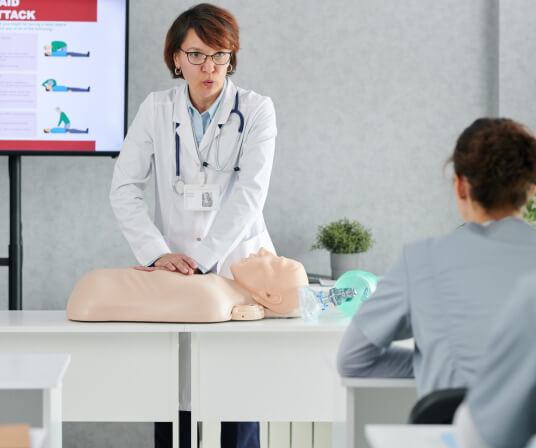

Healthcare, First Aid &
Bloodborne Pathogens
Combo
$49.95 $59.85
| Chapters | CE Credits | Validity | Cost | Duration | ECC | Exam Attempts | Wallet Card |
|---|---|---|---|---|---|---|---|
| 32 | — | 2 Years | $49.95 | 2 Hrs | Compliant | Unlimited | Download/Print/Mail |
- Chapters32
- CE Credits—
- Validity2 Years
- Cost$49.95
- Duration2 Hrs
- ECCCompliant
- Exam AttemptsUnlimited
- Wallet CardDownload/Print/Mail
Chapter 7: 2-Rescuer CPR And Bag-Mask
When a second rescuer is available to help, the duties are split amongst the two rescuers. The specific responsibilities are listed below:
Rescuer 1:
- Rescuer 1 will begin to perform chest compressions (at victim’s side).
- Compress at least 2 inches (but no more than 2.4 inches deep for adults) at the center of the chest
- At least 100 to 120 compressions per minute in cycles of 30 compressions to 2 breaths
- Allow the chest to completely rise after each compression
- Switch giving compressions every 5 cycles or approximately every 2 minutes.
Rescuer 2:
- Rescuer 2 will activate the Emergency Response System (call 9-1-1) and get the AED.
- Keep the airway open and be ready to give breaths, using a bag-mask, after every 30 compressions until it’s time to switch.
- Encourage rescuer 1 to give effective chest compressions.
- If additional rescuers (team) arrive, they can help with the bag-mask ventilation and with the usage of the AED.
Bag-Mask Technique:
This is a device which consists of a bag attached to a face mask and is readily available in a hospital setting. Using a bag valve mask is recommended for 2-rescuer CPR. It’s important to understand that the use of a bag-mask is difficult, and requires considerable practice before it can be done on a patient.
First, you must select a mask that will effectively cover the mouth and nose of a patient to create a tight seal. The patient’s face should be pulled up into the mask for best results (be sure not to crush the mask into the face). Then attach the mask to the bag device, which should be attached to high flow oxygen (15L per minute). The bag should be fully inflated.
Then perform the head-tilt chin-lift motion to open the airway, and give 2 breaths (1 second each). Be sure to watch for the rise and fall of the chest between breaths. If the patient’s chest does not rise and fall between each breath: check for obstructions, ensure that there is a tight seal to the face and that the airway is open.



